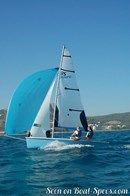RS Venture SE
Sailboat specifications
The RS Venture is a 16’4” (4.98m) multiple crew dinghy designed by Phil Morrisson (United Kingdom). She is built since 2010 by RS Sailing (United Kingdom). The SE version features a ballasted centerboard to increase the stability.
The RS Venture is as well listed, on Boat-Specs.com, in S and Connect version (see all the versions compared).
The RS Venture is as well listed, on Boat-Specs.com, in S and Connect version (see all the versions compared).
RS Venture's main features
- Model
- RS Venture
- Version
- SE
- Hull type
- Monohull
- Category
- Multiple crew dinghy
- Sailboat builder
- Sailboat designer
- Country
- United Kingdom
- Construction
- GRP (glass reinforced polyester):
Sandwich foam fiberglass polyester - First built hull
- 2010
- Last built hull
- Still in production
- Appendages
- Centerboard : pivoting centerboard
- Helm
- Single tiller
- Rudder
- Single transom hung rudder
- Unsinkable
- No
- Trailerable
- Yes
- EC design categoryiThe CE design category indicates the ability to cope with certain weather conditions (the sailboat is designed for these conditions)
A: Wind < force 9, Waves < 10m
B: Wind < force 8, Waves < 8m
C: Wind < force 6, Waves < 4m
D: Wind < force 4, Waves < 0,5m - C
- Standard public price ex. VAT (indicative only)
- About11 600 €(2020)
RS Venture's main dimensions
- Hull length
- 16’ 4”4.98 m
- Beam (width)
- 6’ 8”2.03 m
- Draft
- 3’ 10”1.15 m
- Light displacement (MLC)
- 661 lb300 kg
- Ballast weight
- 132 lb60 kg
- Ballast type
- Cast iron
RS Venture's rig and sails
- Upwind sail area
- 159 ft²14.8 m²
- Downwind sail area
- 269 ft²25 m²
- Mainsail area
- 118 ft²11 m²
- Jib area
- 41 ft²3.8 m²
- Asymmetric spinnaker area
- 151 ft²14 m²
- Rigging type
- Sloop Marconi fractional
- Mast configuration
- Deck stepped mast
- Rotating spars
- No
- Number of levels of spreaders
- 1
- Spreaders angle
- Swept-back
- Spars construction
- Aluminum spars
- Standing rigging
- 1x19 strand wire continuous
RS Venture's performances
- Crew
- < 640kg
- Upwind sail area to displacementiThe ratio sail area to displacement is obtained by dividing the sail area by the boat's displaced volume to the power two-thirds.
The ratio sail area to displacement can be used to compare the relative sail plan of different sailboats no matter what their size.
Upwind: under 18 the ratio indicates a cruise oriented sailboat with limited performances especially in light wind, while over 25 it indicates a fast sailboat. - 356 ft²/T33.03 m²/T
- Downwind sail area to displacementiThe ratio sail area to displacement is obtained by dividing the sail area by the boat's displaced volume to the power two-thirds.
The ratio sail area to displacement can be used to compare the relative sail plan of different sailboats no matter what their size. - 601 ft²/T55.79 m²/T
- Ballast ratioiThe Ballast ratio is an indicator of stability; it is obtained by dividing the boat's displacement by the mass of the ballast. Since the stability depends also of the hull shapes and the position of the center of gravity, only the boats with similar ballast arrangements and hull shapes should be compared.
The higher the ballast ratio is, the greater is the stability. - 20 %
RS Venture's auxiliary engine
- Engine(s)
- Outboard engine
RS Venture's accommodations and layout
- Cockpit
- Closed aft cockpit





RS Sailing RS Venture sailing - - 4/9
Picture extracted from the commercial documentation © RS Sailing
Picture extracted from the commercial documentation © RS Sailing


RS Sailing RS Venture sailing - - 5/9
Picture extracted from the commercial documentation © RS Sailing
Picture extracted from the commercial documentation © RS Sailing


RS Sailing RS Venture sailing - - 6/9
Picture extracted from the commercial documentation © RS Sailing
Picture extracted from the commercial documentation © RS Sailing


RS Sailing RS Venture sailing - - 7/9
Picture extracted from the commercial documentation © RS Sailing
Picture extracted from the commercial documentation © RS Sailing


RS Sailing RS Venture sailing - - 8/9
Picture extracted from the commercial documentation © RS Sailing
Picture extracted from the commercial documentation © RS Sailing


RS Sailing RS Venture detail - - 9/9
Picture extracted from the commercial documentation © RS Sailing
Picture extracted from the commercial documentation © RS Sailing
Similar sailboats that may interest you:
Sailboats
First built hull
Hull length
1994
14’ 10”4.52 m
1995
13’ 1”4 m
2015
14’ 1”4.29 m
1998
16’ 2”4.94 m
1998
14’ 7”4.44 m
2006
14’ 2”4.34 m
1997
14’ 2”4.32 m
1983
14’ 2”4.32 m
1994
16’ 4”4.98 m
2008
15’ 1”4.6 m
2008
14’ 6”4.42 m
2003
14’ 6”4.42 m
2010
16’ 4”4.98 m
2018
19’ 8”5.99 m
1999
17’5.18 m